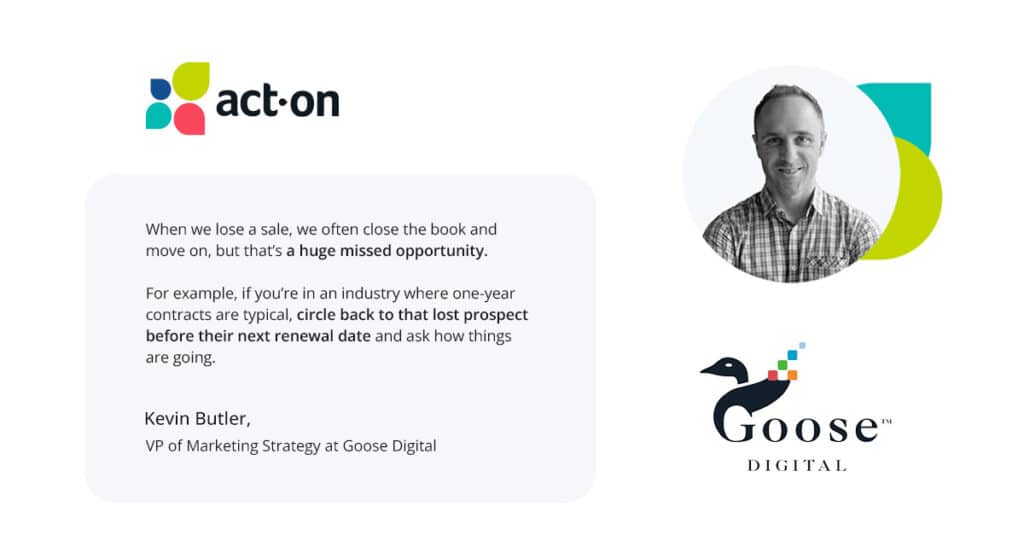Shrinking budgets, rising expectations, and a growing disconnect between CEOs and CMOs about the “most important” marketing metrics lead to more questions than answers about how to expand pipeline.
According to a recent report, the probability of CEOs and marketing leaders agreeing on top marketing metrics is like a flip of a coin (50/50).
But despite a growing disconnect, most can agree on one important priority: revenue growth. And achieving that is rooted in supporting pipeline expansion.
We tapped Jeff Day, SVP of Marketing at Act-On Software, and Kevin Butler, VP of Marketing & Strategy at Goose Digital, to share their favorite strategies marketing leaders can use to help sales build a pipeline in 2024. When considering the future, both are very optimistic about market changes, trends, and the opportunities they provide marketers who understand how to leverage them to create an advantage.
How marketing can help sales nurture prospects to create opportunities
Relevance to your audience’s needs, aligning it with your lead nurture efforts, and following up effectively are critical areas of focus when building a marketing pipeline, according to Jeff.

“If you know a prospect is coming to you from a Google ad on a specific topic, like lead scoring, follow up with lead-scoring content rather than hitting them up right away for a demo,” says Jeff.
Kevin, who leads Goose Digital’s strategy and marketing team, spends his days helping businesses figure out how to compete and win with their target audiences. He explains that it’s important to understand need and intent early.
Part of doing this well involves strategically leveraging first-party data about your audience. For example, marketers often ask for basic information, such as name, email address, and phone number, on forms, but rarely do they ask these two questions:
- When are you looking to make a purchase?
- What is your greatest need?
Capturing this data helps you understand a buyer’s intent and needs from the outset. He also explains that following up with previously lost prospects is a commonly overlooked strategy.
“When we lose a sale, we often close the book and move on, but that’s a huge missed opportunity,” he says. “For example, if you’re in an industry where one-year contracts are typical, circle back to that lost prospect before their next renewal date and ask how things are going.”
Building sales pipeline with a focus on quality over quantity
As you consider how to deliver the best leads to sales, one strategy is central to improving results:
Quality over quantity.
Oftentimes, metrics are based on the quantity of MQLs. But Jeff, who oversees Act-On’s marketing and BDR teams, explains that volume doesn’t matter if the quality isn’t great.
Kevin suggests considering MQLs in the context of your total addressable market (TAM). “When you look at your MQLs, does that number make sense with your TAM?” asks Kevin. “Your team might say, ‘We drove 4,000 leads this month.’ But what if there are only 200 companies in your target market? How is that possible?”
With respect to MQLs, one additional consideration Kevin mentions is the importance of correlation of MQLs to qualified pipeline sales opportunities. “MQLs can be effective indicators of success, but ultimately markerters need to validate consistent conversion from MQLs into real opportunities your sales team can work with.”

Improving the quality of your leads goes back to your lead-scoring system. How do you set them up? And how do you pass only the highest-quality leads to your sales team and ensure BDR teams follow up in a personalized and more meaningful way?
Mastering this challenge is where you can gain traction for driving the best leads to your sales teams and expand pipeline.
How marketing and sales work together with account intelligence
Kevin explains that while it’s the salesperson’s job to close the deal, it’s marketing’s job to give them the “tools” to do so. “We’ve got to arm them with all the information we can so they can do what they are good at, and part of that is providing the right data.”
In other words, marketing needs to make it easy on sales. And doing that means the prospect comes with all the relevant background details, packaged and ready to use.
“A salesperson should be able to look in the system and say, “Okay, I see the background details; let’s schedule a discovery call,” says Jeff. “And what’s the discovery call about? Okay, I see it here; these are the ‘magic pillars’ I need to address.”
And by magic pillars, he means the areas most relevant to the prospect based on the content and previous interactions with your brand.
Scaling demand generation operations and pipeline marketing
Surprisingly, there are many teams still manually sending out marketing campaigns or creating single follow up sequences. But shrinking budgets and heavier demands on marketing teams require scalability.
“Don’t set up small things,” says Jeff. “Think about how to set up a trigger campaign based on a prospect viewing a certain piece of content, for example. Then, once they exit that sequence, they filter into an evergreen nurture sequence.”
The goal is to personalize based on intent and need and build stronger connections at scale. Marketing automation is a big part of that scalability, but it’s important that teams learn to use it and start asking important questions such as: How effective are my emails? Would changing the subject line, CTA, or something else result in better performance?
Run experiments. Pinpoint success. And then use tools like marketing automation to scale and expand that success.
Uncover trends that give your team a competitive advantage
Marketing leaders watch trends carefully, but the tricky part is figuring out how to leverage those trends to expand pipeline. Jeff and Kevin called out a few when asked which trends to watch this year.
- Niche communities grow in importance. According to Kevin, buyers are “going dark” for longer periods of time before becoming known to brands. During these dark periods, they gather intelligence about solutions that address their challenges independently and spend more time in niche communities talking with peers with similar challenges and experiences. “If your target market is spending time in a community, being involved with it will be worth its weight in gold,” says Kevin.
- Recognizing the broader capabilities of AI. Obviously, 2023 was a big year for AI, with ChatGPT hitting the scene. However, according to Jeff, we have to think about AI not only for generative content but also for its broader capabilities like predictive scoring and workflow automation. These help marketers get more value, move faster, and deploy campaigns quicker.
- Google and Yahoo changes highlight the importance of quality over quantity. Quality over quantity will be important in nurturing campaigns with the most recent Yahoo and Google rules. Kevin suggests that marketing scrutinize their lists carefully. They need to understand who is opening emails and who isn’t and pay careful attention to disengaged prospects, because your emails to them could be labeled as spam. He adds, “Remember, it’s not about the size of your list. It’s about the quality and engagement of your list.”
The biggest question you need to answer this year…
Maybe you agree with your CEO on marketing metrics.
Maybe you don’t.
It’s a coin toss, right?
Either way, explains Kevin, when you sit down with your CEO, there is one question they want answered:
How does this turn into dollars?
It’s a fair question. And when you can leverage intelligence and data to support pipeline growth, it makes creating that connection and answering that question much easier.
Does your team need a proven strategy for effective lead-to-pipeline conversion? Steal your favorites! We share them all in this on-demand webinar.
